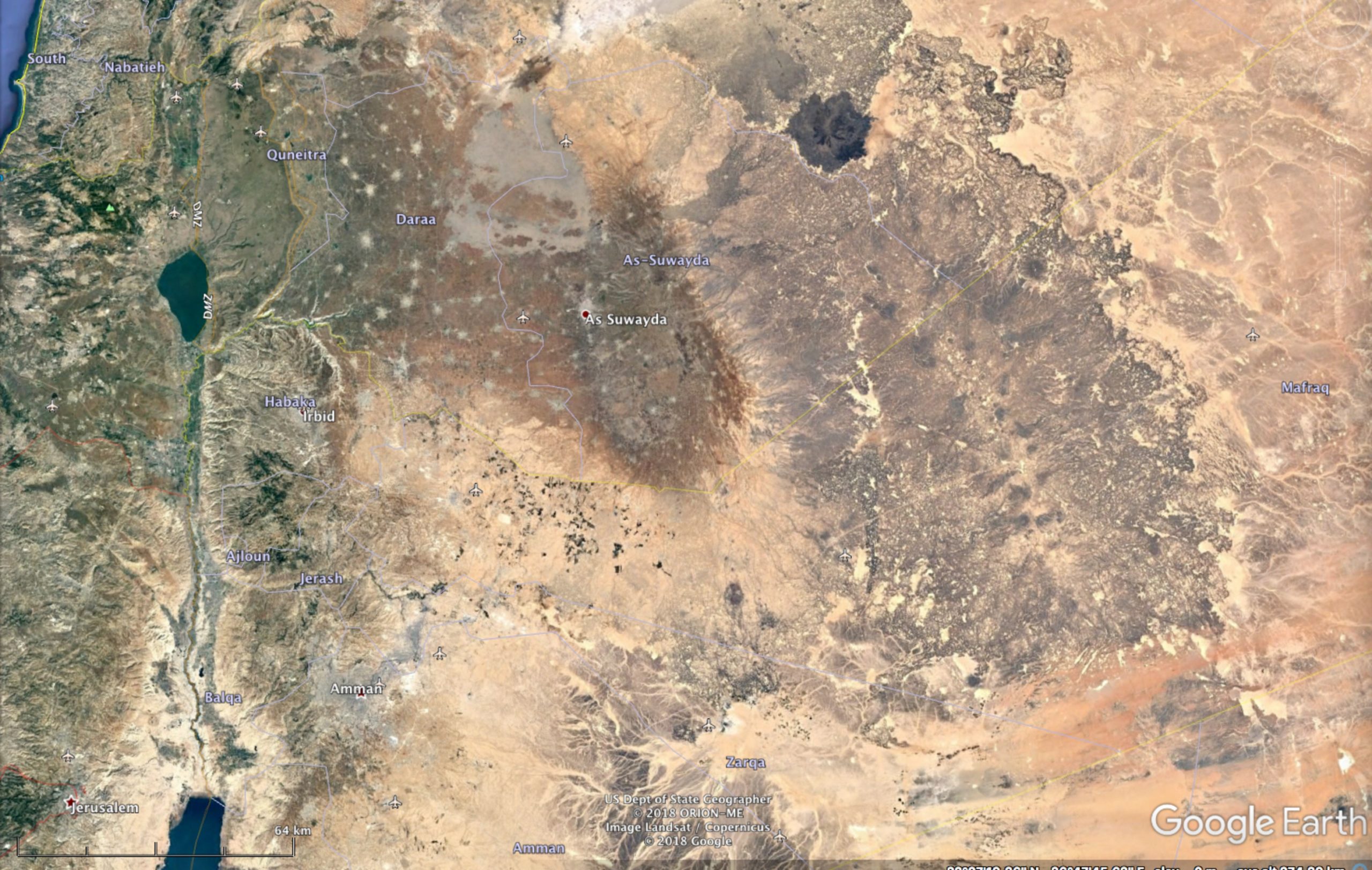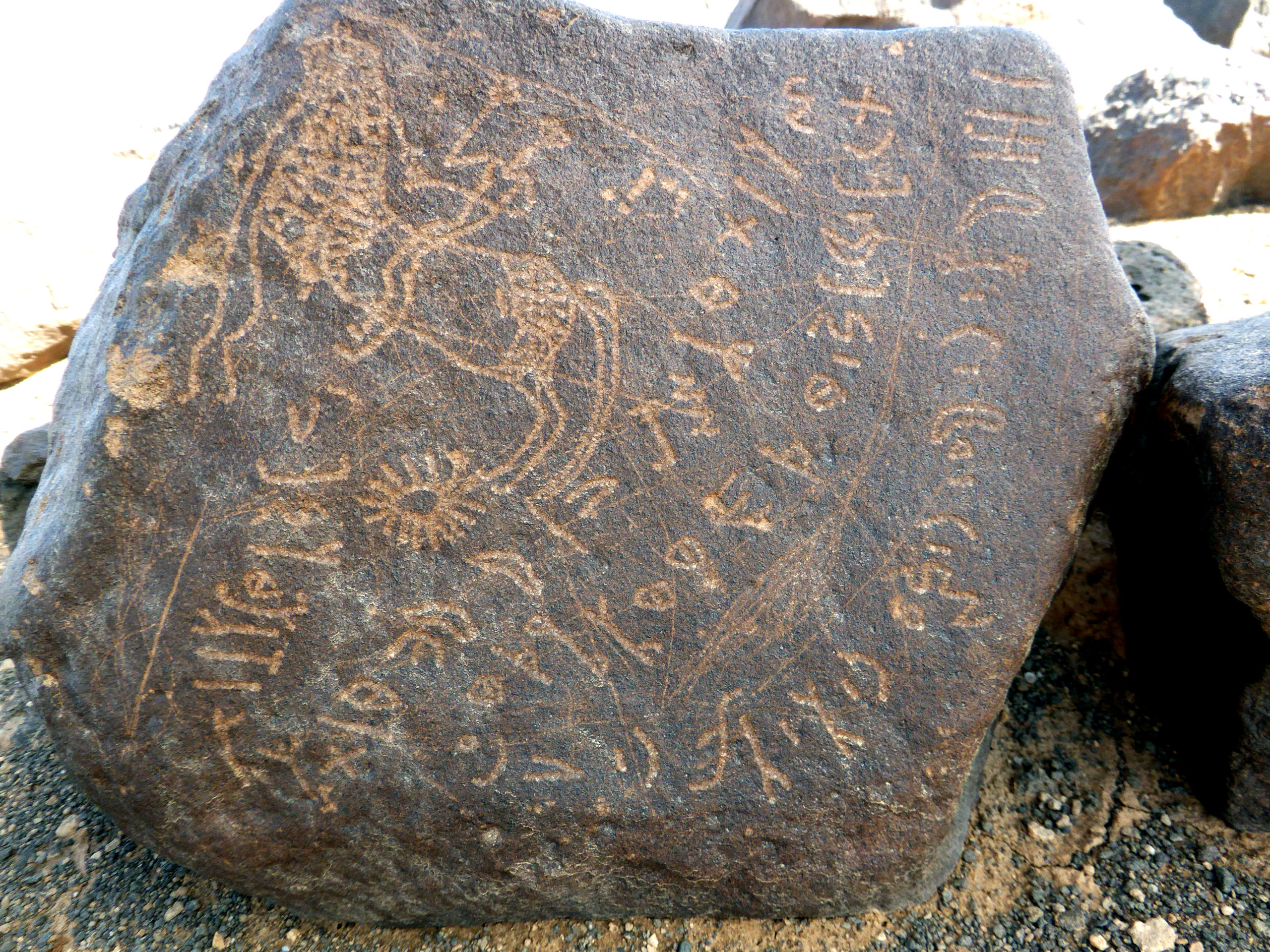

By Michael Macdonald, Fellow of the British Academy and an Honorary Fellow of Wolfson College Oxford.
The Black Desert, known as ḥarra in Arabic, is actually the lava from a large number of ancient volcanoes in the area. Over millions of years, these lava flows have broken up into billions of stones and boulders which now cover the limestone desert floor. Over the millennia the chemicals in the stone have interacted with those in the atmosphere to produce a very thin black patina or “desert varnish” on all the exposed parts of the rocks. But if you scratch one of them, the grey pumice colour shows through and looks almost white against the surrounding black surface. This makes it very attractive for graffiti carvers and today, when the Bedouin are becoming literate again, there is a great flowering of modern Arabic graffiti in the area.

Until recently, when paper became cheap and readily available, reading and writing were skills which nomads didn’t really need. In antiquity, papyrus was expensive outside Egypt and they had more practical things to make from leather, such as water skins, saddle and harness materials, even clothes and tent fittings. In the settled areas, broken pottery was the most common surface for writing on. But the nomads didn’t carry much pottery, since it got broken when they were on the move. So, the only freely available writing surfaces were rocks and these they had in abundance!
However, rocks are not very useful for sending letters or, in a mobile society, writing contracts or recording history or poetry. So these nomads never became dependent on writing in the way that our societies are. They remained a paradox: an oral society which used memory and the spoken word rather than writing, but in which large numbers of people were literate.

What did they use their literacy for? Nomadic life involves a lot of hanging around by oneself, watching the flocks and herds pasture or looking out for game or enemies. The one thing they desperately needed, therefore, was something to pass the time when doing these jobs; and carving graffiti was the perfect answer. Many of them had already been carving rock drawings and now they could sign them.
Because they had all the time in the world they could often carve quite long graffiti saying what they were doing, things they had done in the past or were intending to do, and above all expressing their emotions, particularly sadness. Reading them can be like getting a text or a tweet from a friend across 2000 years. However, they also had an earthy sense of humour and sometimes added rude remarks to someone else’s graffito!
These nomads carved literally tens of thousands of graffiti in the black desert and beyond. Together they provide the only indigenous written source for the history of the nomads in the Nabataean and Roman period and give a vivid picture of their society, their daily life, their religion, and their relations with the settled peoples. Their contemporaries in the villages and towns either did not know how to write, or did not have time, or carved graffiti which have since been destroyed. So, ironically, we know far more about the nomads at this period than about any other community in the region.
More than 35,000 Safaitic inscriptions are known at present and new ones are constantly being discovered. So, in 2013 a project was set up at the Khalili Research Centre, University of Oxford, to enter them all (plus all the other inscriptions from pre-Islamic Arabia) into a digital database. This is called the Online Corpus of the Inscriptions of Ancient North Arabia (OCIANA) and is available on (http://krc.orient.ox.ac.uk/ociana/index.php) together with PDFs of the collections and information about the various types of inscription in ancient North Arabia.
Unfortunately, many inscriptions were originally published with little, no, or inaccurate geographical information and without photographs. So, in 2015, Ali Al-Manaser and Michael C.A. Macdonald who were members of the OCIANA team, decided to go back into the black desert to try to find these badly recorded inscriptions, photograph them and get accurate GPS points for them. This project was supported by generous grants from the CBRL, Wolfson College Oxford, and the Seven Pillars of Wisdom Trust.
The survey was a great success and as well as finding large numbers of inscriptions which had been previously published, the systematic search and recording methods we used meant that we also found a great many new texts, some of them extremely interesting.
In 2017 and 2018, we continued the survey in different parts of the ḥarrah, again with the vital and generous support of the CBRL and the other institutions. In April 2018, we surveyed along the eastern edge of the black desert, where the lava runs out and the underlying limestone desert emerges. This was a particularly interesting area because it was where many of the nomads waited for the first rains of the year, in October, before taking their herds into the limestone desert to enjoy the pasture the rains had brought forth.
All the corrections to previously published inscriptions, and the photographs, as well as all the new inscriptions, are being entered into OCIANA where they are freely available online. Once again, we would like to thank the CBRL not only for its generous grants which made these surveys possible but for the hospitality of the staff at the British Institute at Amman.
Michael C.A. Macdonald has been working on the ancient history, languages, scripts and inscriptions of Jordan, Syria and Arabia since 1975. He has led numerous surveys in all three countries to record the tens of thousands of inscriptions in the deserts. He has also written widely on the ancient history of Arabia, ancient literacy, nomads, rock art, etc. He co-directed OCIANA and co-directs the Badia Epigraphic Survey Project. He has served many times on the committee of the CBRL, and that of its predecessor the British Institute at Amman for Archaeology and History. He is a Fellow of the British Academy and an Honorary Fellow of Wolfson College Oxford.
The views expressed by our authors on the CBRL blog are not necessarily endorsed by CBRL, but are commended as contributing to public debate.











